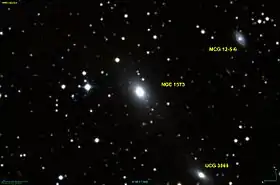NGC 1573
NGC 1573 is an elliptical galaxy in the constellation of Camelopardalis.[2] It was discovered on 1 August 1883 by Wilhelm Tempel.[4] It was described as "very faint, small" by John Louis Emil Dreyer, the compiler of the New General Catalogue.[4] It is located about 190 million light-years (58 megaparsecs) away.[2]
| NGC 1573 | |
|---|---|
 DSS image of NGC 1573 | |
| Observation data (J2000 epoch) | |
| Constellation | Camelopardalis |
| Right ascension | 04h 35m 03.975s[1] |
| Declination | +73° 15′ 44.66″[1] |
| Redshift | 0.014080[2] |
| Helio radial velocity | 4221 km/s[2] |
| Distance | 188.84 ± 15.59 Mly (57.900 ± 4.781 Mpc)[2] |
| Apparent magnitude (V) | 11.50[2] |
| Apparent magnitude (B) | 13.3[3] |
| Absolute magnitude (V) | −22.31[2] |
| Characteristics | |
| Type | E[2] |
| Size | 112,200 ly (34,390 pc)[2][note 1] |
| Apparent size (V) | 2.042′[2][note 1] |
| Other designations | |
| UGC 3077, MGC+12-05-008, PGC 15570[3] | |
The galaxy PGC 16052 is not a NGC object, nor is it physically associated with NGC 1573, but is often called NGC 1573A. It is an intermediate spiral galaxy with an apparent magnitude of about 14.0.[4] In 2010, a supernova was discovered in PGC 16052 and was designated as SN 2010X.[5]
References
- Skrutskie, M. (2006). "The Two Micron All Sky Survey (2MASS)". The Astronomical Journal. 131 (2): 1163–1183. Bibcode:2006AJ....131.1163S. doi:10.1086/498708.
- "NED results for object NGC 1573". National Aeronautics and Space Administration / Infrared Processing and Analysis Center. Retrieved 6 September 2017.
- "NGC 1573". SIMBAD. Centre de données astronomiques de Strasbourg. Retrieved 6 September 2017.
- "New General Catalog Objects: NGC 1550 - 1599". cseligman.com. Retrieved 6 September 2017.
- Rich, D.; Burke, P. (2010). "Supernova 2010X in NGC 1573A". Central Bureau Electronic Telegrams. 2166 (2166): 1. Bibcode:2010CBET.2166....1R.
Notes
- RC3 D0 (blue) values used.
This article is issued from Wikipedia. The text is licensed under Creative Commons - Attribution - Sharealike. Additional terms may apply for the media files.